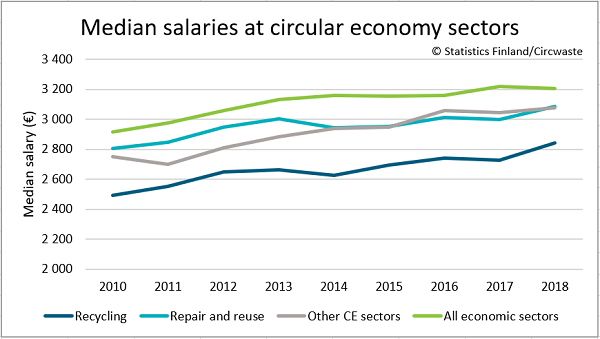Circular economy aims at increasing the wellbeing of people through economic growth and creation of new jobs. The overall numbers of employment, however, do not tell much about the quality of the employment. What kind of employment opportunities the circular economy introduces? Does circular economy embed equal opportunities for people despite their social standing?
The employment indicators measure how the circular economy employment opportunities are socially distributed. The indicators measure the average income in circular economy sector jobs, division of jobs between different background education categories and employment opportunities of vulnerable groups.
Data for the income and background education in circular economy sector jobs is produced by the Statistics Finland. The indicators are produced only on national level.
Data for vulnerable groups’ employment is received from the Employment Service Statistics compiled by the Ministry of Economic Affairs and Employment. The indicator focuses on the employment of people as refuse sorters through work trials and wage subsidies in the different regions. People who work as refuse sorters work in tasks related to the take-back, collection, sorting and handling of paper, cardboard, metal, glass and plastic. The work can also be related to the receiving or selling used things, furniture, clothes and equipment. Work trials and wage subsidies, in turn, are public labour services targeted especially at vulnerable groups such as uneducated youth, immigrants, disabled and long-term unemployed.
Work trials and wage subsidies are public labour services targeted especially at vulnerable groups such as uneducated youth, immigrants, disabled and long-term unemployed. Through work trials a person can for example figure out, are they interested in a certain job or career, is their competence up to date after being off from the job market for example because of unemployment or taking care of kids, or could entrepreneurship be a suitable career option for them. A work trial lasts maximum of 12 months, max 6 months in the same duty, and maximum 5 workdays a week and 4–8 hours a day.
Wage subsidies, on the other hand, are an economic support in which a TE Office grants an employer to cover the pay costs of a jobseeker who is unemployed, and it’s meant for people whose unemployment is estimated to be shortcomings of professional competence, or if for example a person’s disability or illness affects on their work in the position offered essentially, permanently, or continuously. The pay subsidy can be maximum 30, 40, or 50% of pay costs and last max. 6 to 36 months depending on a situation at hand.
Average income and background education
The indicators have originally been published by the Statistics Finland. The data and used definitions are described in more detail at the website.
The median salaries in circular economy sectors are lower than the average income in Finland. Those working in the recycling jobs have the lowest salaries. The development of salaries at the circular economy sectors have been similar to the development of the overall median salaries.

The median salaries in circular economy sectors are lower than the average income in Finland. © Statistics Finland/Circwaste
Most of the people employed at circular economy jobs have vocational education. The share of those with vocational and higher education have been similar throughout the 2010s.

Most of people employed at circular economy jobs have vocational education. © Statistics Finland/Circwaste
Vulnerable groups’ employment
Out of the over 1.100 different job titles, refuse sorter is of the most common occupation for work trials and wage subsidised work. The importance of recycling work has increased during the past years in whole Finland so that the share of refuse sorters is already over 4% of all subsidised employment in Finland. There has been increase also on the regional level, although also a lot of variation between different regions.
The results suggest that the importance of CE related work is increasing for providing employment opportunities for the vulnerable groups with limited professional skills. A closer assessment reveals that refuse sorters have often been unemployed longer than 2 years and they are more often men than women. Many of the refuse sorters in subsidised employment also have an immigrant background.
More information
- Senior Research Scientist Kati Pitkänen, Finnish Environment Institute SYKE, firstname.lastname@syke.fi
- Researcher Tiina Karppinen, Finnish Environment Institute SYKE, firstname.lastname@syke.fi